Human Resource Management: Practices, Challenges, and Benefits
VerifiedAdded on 2020/02/05
|7
|1781
|49
Essay
AI Summary
This essay delves into the crucial role of Human Resource Management (HRM) in modern business operations. It emphasizes HRM's significance in achieving competitive advantage, profitability, and market share by effectively managing and retaining skilled employees. The essay explores various facets of HRM, including employee management, performance appraisals, training and development, compensation, and employee engagement. It highlights how HRM practices are evolving and contributing to economic growth, replacing traditional personnel management. The essay also examines the differences between soft and hard HRM, the application of the Harvard and David Guest models, and the impact of globalization and technological advancements on HRM practices. It concludes by underscoring the vital role of HRM in organizational success and the importance of HR professionals staying updated with the latest trends.

ENGLISH FOR ACADMIC
PURPOSE
PURPOSE
Paraphrase This Document
Need a fresh take? Get an instant paraphrase of this document with our AI Paraphraser

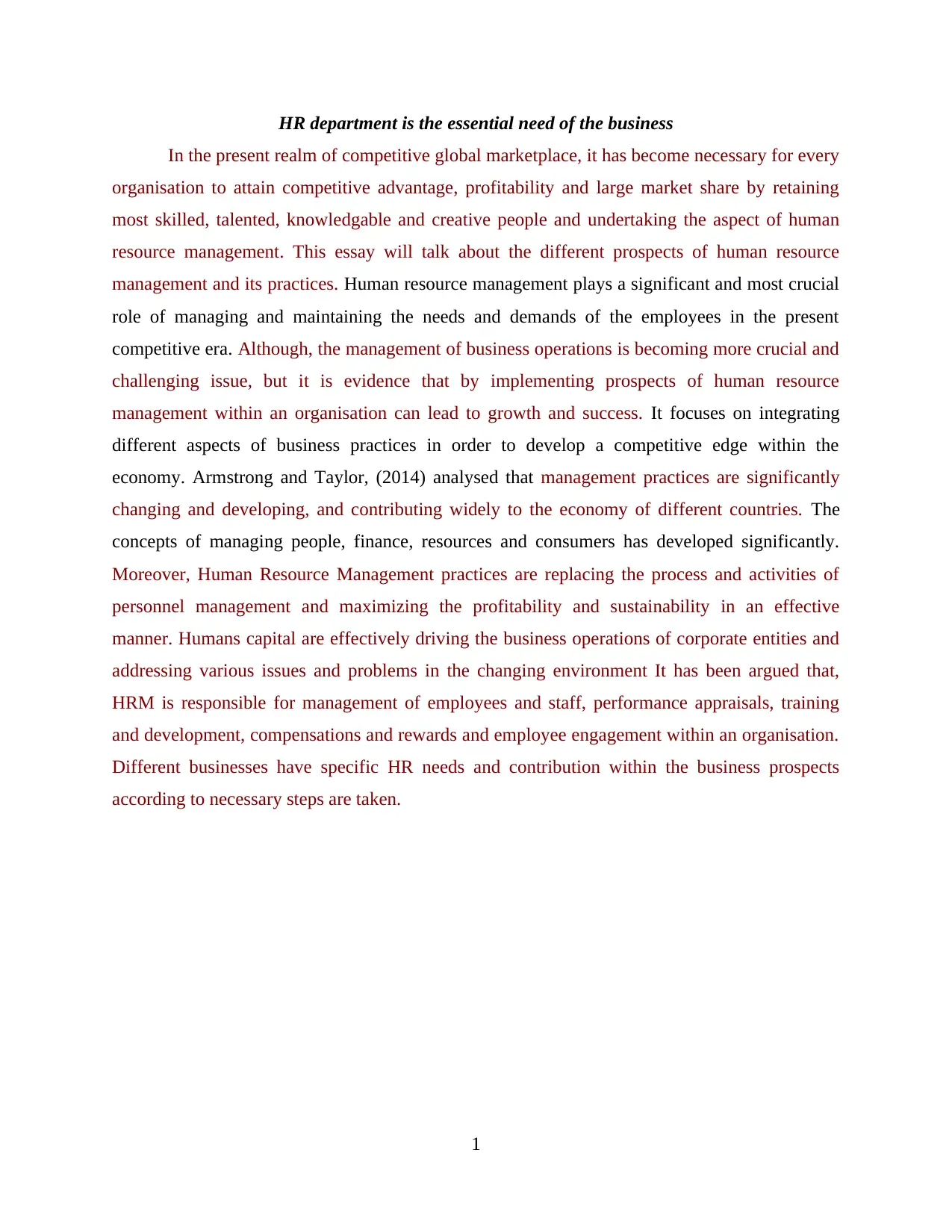
HR department is the essential need of the business
In the present realm of competitive global marketplace, it has become necessary for every
organisation to attain competitive advantage, profitability and large market share by retaining
most skilled, talented, knowledgable and creative people and undertaking the aspect of human
resource management. This essay will talk about the different prospects of human resource
management and its practices. Human resource management plays a significant and most crucial
role of managing and maintaining the needs and demands of the employees in the present
competitive era. Although, the management of business operations is becoming more crucial and
challenging issue, but it is evidence that by implementing prospects of human resource
management within an organisation can lead to growth and success. It focuses on integrating
different aspects of business practices in order to develop a competitive edge within the
economy. Armstrong and Taylor, (2014) analysed that management practices are significantly
changing and developing, and contributing widely to the economy of different countries. The
concepts of managing people, finance, resources and consumers has developed significantly.
Moreover, Human Resource Management practices are replacing the process and activities of
personnel management and maximizing the profitability and sustainability in an effective
manner. Humans capital are effectively driving the business operations of corporate entities and
addressing various issues and problems in the changing environment It has been argued that,
HRM is responsible for management of employees and staff, performance appraisals, training
and development, compensations and rewards and employee engagement within an organisation.
Different businesses have specific HR needs and contribution within the business prospects
according to necessary steps are taken.
1
In the present realm of competitive global marketplace, it has become necessary for every
organisation to attain competitive advantage, profitability and large market share by retaining
most skilled, talented, knowledgable and creative people and undertaking the aspect of human
resource management. This essay will talk about the different prospects of human resource
management and its practices. Human resource management plays a significant and most crucial
role of managing and maintaining the needs and demands of the employees in the present
competitive era. Although, the management of business operations is becoming more crucial and
challenging issue, but it is evidence that by implementing prospects of human resource
management within an organisation can lead to growth and success. It focuses on integrating
different aspects of business practices in order to develop a competitive edge within the
economy. Armstrong and Taylor, (2014) analysed that management practices are significantly
changing and developing, and contributing widely to the economy of different countries. The
concepts of managing people, finance, resources and consumers has developed significantly.
Moreover, Human Resource Management practices are replacing the process and activities of
personnel management and maximizing the profitability and sustainability in an effective
manner. Humans capital are effectively driving the business operations of corporate entities and
addressing various issues and problems in the changing environment It has been argued that,
HRM is responsible for management of employees and staff, performance appraisals, training
and development, compensations and rewards and employee engagement within an organisation.
Different businesses have specific HR needs and contribution within the business prospects
according to necessary steps are taken.
1
⊘ This is a preview!⊘
Do you want full access?
Subscribe today to unlock all pages.

Trusted by 1+ million students worldwide
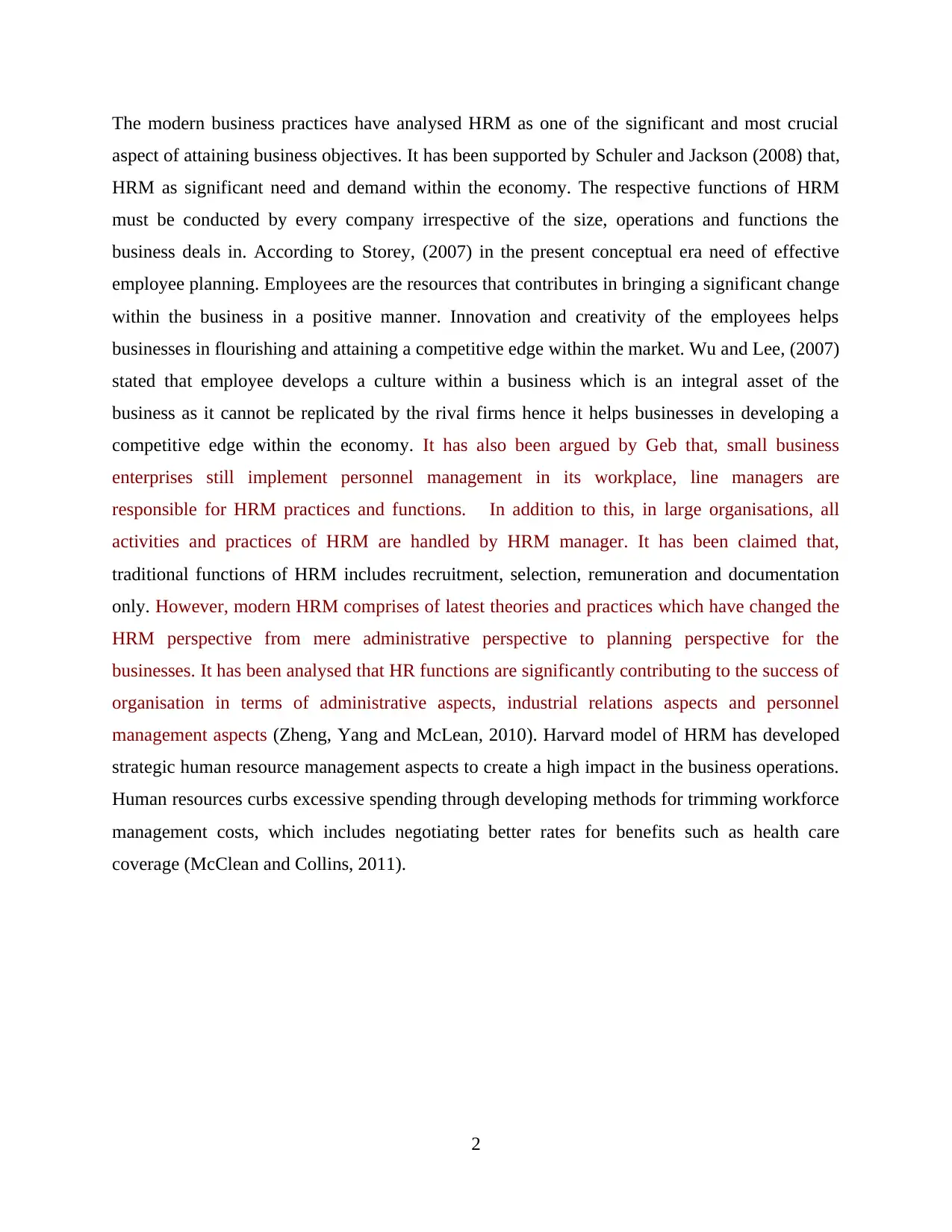
The modern business practices have analysed HRM as one of the significant and most crucial
aspect of attaining business objectives. It has been supported by Schuler and Jackson (2008) that,
HRM as significant need and demand within the economy. The respective functions of HRM
must be conducted by every company irrespective of the size, operations and functions the
business deals in. According to Storey, (2007) in the present conceptual era need of effective
employee planning. Employees are the resources that contributes in bringing a significant change
within the business in a positive manner. Innovation and creativity of the employees helps
businesses in flourishing and attaining a competitive edge within the market. Wu and Lee, (2007)
stated that employee develops a culture within a business which is an integral asset of the
business as it cannot be replicated by the rival firms hence it helps businesses in developing a
competitive edge within the economy. It has also been argued by Geb that, small business
enterprises still implement personnel management in its workplace, line managers are
responsible for HRM practices and functions. In addition to this, in large organisations, all
activities and practices of HRM are handled by HRM manager. It has been claimed that,
traditional functions of HRM includes recruitment, selection, remuneration and documentation
only. However, modern HRM comprises of latest theories and practices which have changed the
HRM perspective from mere administrative perspective to planning perspective for the
businesses. It has been analysed that HR functions are significantly contributing to the success of
organisation in terms of administrative aspects, industrial relations aspects and personnel
management aspects (Zheng, Yang and McLean, 2010). Harvard model of HRM has developed
strategic human resource management aspects to create a high impact in the business operations.
Human resources curbs excessive spending through developing methods for trimming workforce
management costs, which includes negotiating better rates for benefits such as health care
coverage (McClean and Collins, 2011).
2
aspect of attaining business objectives. It has been supported by Schuler and Jackson (2008) that,
HRM as significant need and demand within the economy. The respective functions of HRM
must be conducted by every company irrespective of the size, operations and functions the
business deals in. According to Storey, (2007) in the present conceptual era need of effective
employee planning. Employees are the resources that contributes in bringing a significant change
within the business in a positive manner. Innovation and creativity of the employees helps
businesses in flourishing and attaining a competitive edge within the market. Wu and Lee, (2007)
stated that employee develops a culture within a business which is an integral asset of the
business as it cannot be replicated by the rival firms hence it helps businesses in developing a
competitive edge within the economy. It has also been argued by Geb that, small business
enterprises still implement personnel management in its workplace, line managers are
responsible for HRM practices and functions. In addition to this, in large organisations, all
activities and practices of HRM are handled by HRM manager. It has been claimed that,
traditional functions of HRM includes recruitment, selection, remuneration and documentation
only. However, modern HRM comprises of latest theories and practices which have changed the
HRM perspective from mere administrative perspective to planning perspective for the
businesses. It has been analysed that HR functions are significantly contributing to the success of
organisation in terms of administrative aspects, industrial relations aspects and personnel
management aspects (Zheng, Yang and McLean, 2010). Harvard model of HRM has developed
strategic human resource management aspects to create a high impact in the business operations.
Human resources curbs excessive spending through developing methods for trimming workforce
management costs, which includes negotiating better rates for benefits such as health care
coverage (McClean and Collins, 2011).
2
Paraphrase This Document
Need a fresh take? Get an instant paraphrase of this document with our AI Paraphraser
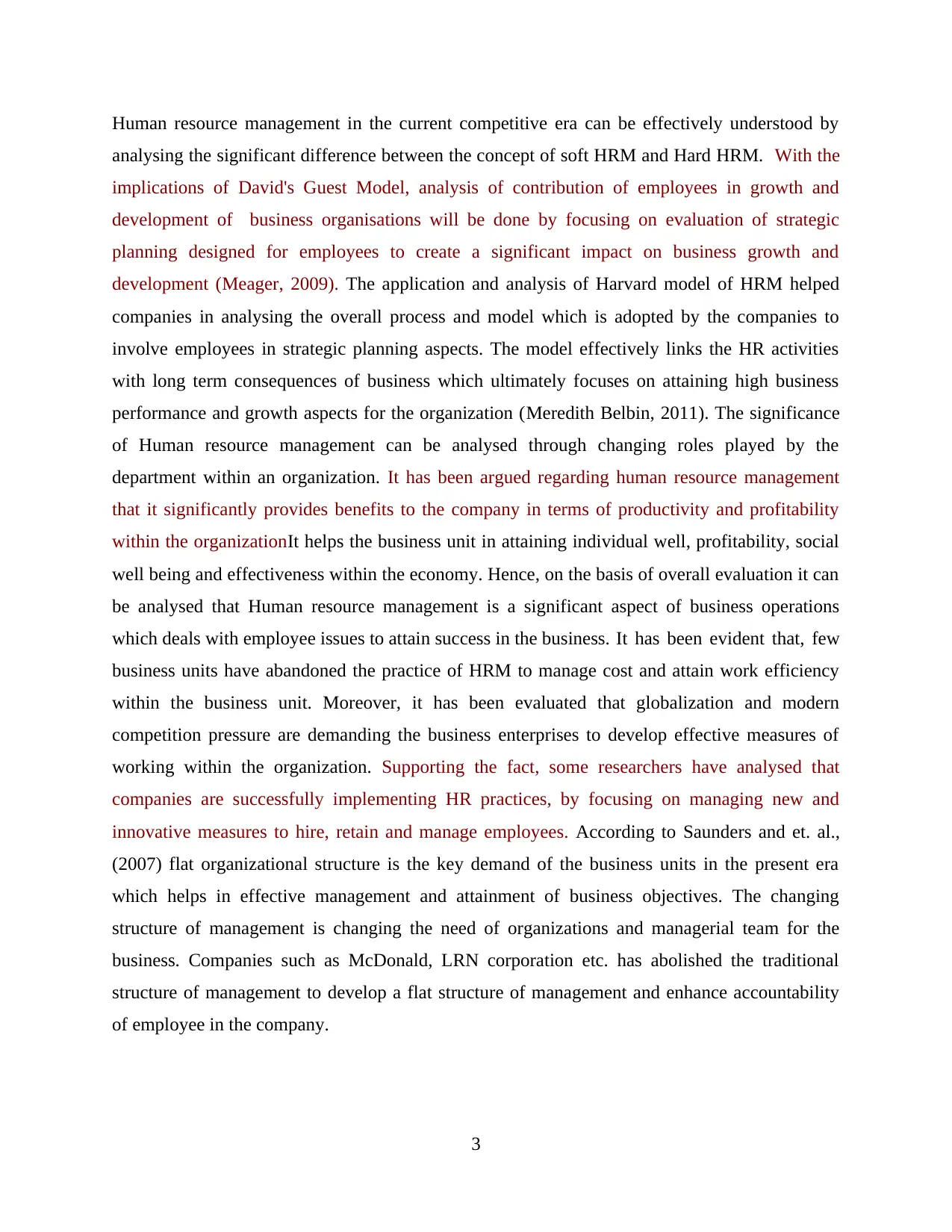
Human resource management in the current competitive era can be effectively understood by
analysing the significant difference between the concept of soft HRM and Hard HRM. With the
implications of David's Guest Model, analysis of contribution of employees in growth and
development of business organisations will be done by focusing on evaluation of strategic
planning designed for employees to create a significant impact on business growth and
development (Meager, 2009). The application and analysis of Harvard model of HRM helped
companies in analysing the overall process and model which is adopted by the companies to
involve employees in strategic planning aspects. The model effectively links the HR activities
with long term consequences of business which ultimately focuses on attaining high business
performance and growth aspects for the organization (Meredith Belbin, 2011). The significance
of Human resource management can be analysed through changing roles played by the
department within an organization. It has been argued regarding human resource management
that it significantly provides benefits to the company in terms of productivity and profitability
within the organizationIt helps the business unit in attaining individual well, profitability, social
well being and effectiveness within the economy. Hence, on the basis of overall evaluation it can
be analysed that Human resource management is a significant aspect of business operations
which deals with employee issues to attain success in the business. It has been evident that, few
business units have abandoned the practice of HRM to manage cost and attain work efficiency
within the business unit. Moreover, it has been evaluated that globalization and modern
competition pressure are demanding the business enterprises to develop effective measures of
working within the organization. Supporting the fact, some researchers have analysed that
companies are successfully implementing HR practices, by focusing on managing new and
innovative measures to hire, retain and manage employees. According to Saunders and et. al.,
(2007) flat organizational structure is the key demand of the business units in the present era
which helps in effective management and attainment of business objectives. The changing
structure of management is changing the need of organizations and managerial team for the
business. Companies such as McDonald, LRN corporation etc. has abolished the traditional
structure of management to develop a flat structure of management and enhance accountability
of employee in the company.
3
analysing the significant difference between the concept of soft HRM and Hard HRM. With the
implications of David's Guest Model, analysis of contribution of employees in growth and
development of business organisations will be done by focusing on evaluation of strategic
planning designed for employees to create a significant impact on business growth and
development (Meager, 2009). The application and analysis of Harvard model of HRM helped
companies in analysing the overall process and model which is adopted by the companies to
involve employees in strategic planning aspects. The model effectively links the HR activities
with long term consequences of business which ultimately focuses on attaining high business
performance and growth aspects for the organization (Meredith Belbin, 2011). The significance
of Human resource management can be analysed through changing roles played by the
department within an organization. It has been argued regarding human resource management
that it significantly provides benefits to the company in terms of productivity and profitability
within the organizationIt helps the business unit in attaining individual well, profitability, social
well being and effectiveness within the economy. Hence, on the basis of overall evaluation it can
be analysed that Human resource management is a significant aspect of business operations
which deals with employee issues to attain success in the business. It has been evident that, few
business units have abandoned the practice of HRM to manage cost and attain work efficiency
within the business unit. Moreover, it has been evaluated that globalization and modern
competition pressure are demanding the business enterprises to develop effective measures of
working within the organization. Supporting the fact, some researchers have analysed that
companies are successfully implementing HR practices, by focusing on managing new and
innovative measures to hire, retain and manage employees. According to Saunders and et. al.,
(2007) flat organizational structure is the key demand of the business units in the present era
which helps in effective management and attainment of business objectives. The changing
structure of management is changing the need of organizations and managerial team for the
business. Companies such as McDonald, LRN corporation etc. has abolished the traditional
structure of management to develop a flat structure of management and enhance accountability
of employee in the company.
3
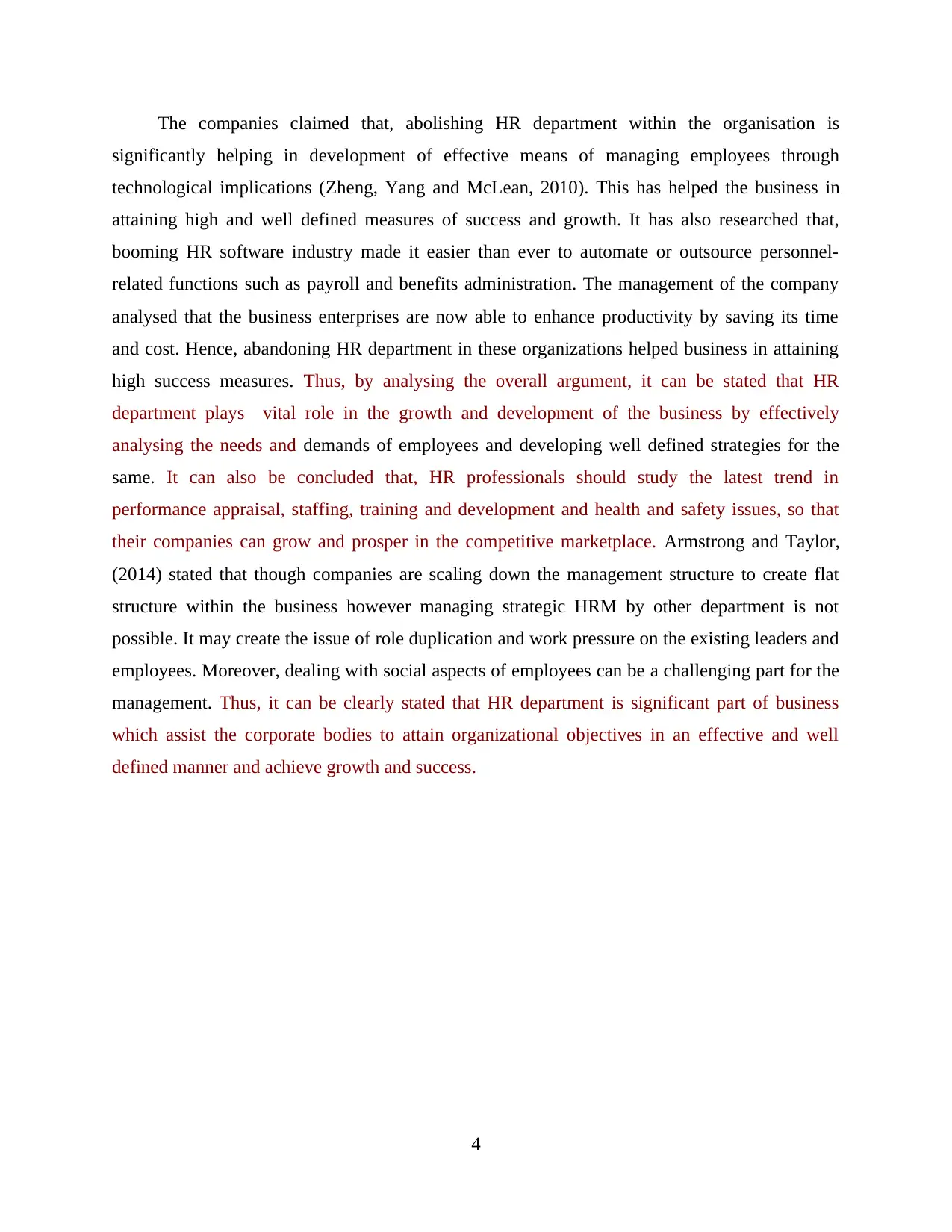
The companies claimed that, abolishing HR department within the organisation is
significantly helping in development of effective means of managing employees through
technological implications (Zheng, Yang and McLean, 2010). This has helped the business in
attaining high and well defined measures of success and growth. It has also researched that,
booming HR software industry made it easier than ever to automate or outsource personnel-
related functions such as payroll and benefits administration. The management of the company
analysed that the business enterprises are now able to enhance productivity by saving its time
and cost. Hence, abandoning HR department in these organizations helped business in attaining
high success measures. Thus, by analysing the overall argument, it can be stated that HR
department plays vital role in the growth and development of the business by effectively
analysing the needs and demands of employees and developing well defined strategies for the
same. It can also be concluded that, HR professionals should study the latest trend in
performance appraisal, staffing, training and development and health and safety issues, so that
their companies can grow and prosper in the competitive marketplace. Armstrong and Taylor,
(2014) stated that though companies are scaling down the management structure to create flat
structure within the business however managing strategic HRM by other department is not
possible. It may create the issue of role duplication and work pressure on the existing leaders and
employees. Moreover, dealing with social aspects of employees can be a challenging part for the
management. Thus, it can be clearly stated that HR department is significant part of business
which assist the corporate bodies to attain organizational objectives in an effective and well
defined manner and achieve growth and success.
4
significantly helping in development of effective means of managing employees through
technological implications (Zheng, Yang and McLean, 2010). This has helped the business in
attaining high and well defined measures of success and growth. It has also researched that,
booming HR software industry made it easier than ever to automate or outsource personnel-
related functions such as payroll and benefits administration. The management of the company
analysed that the business enterprises are now able to enhance productivity by saving its time
and cost. Hence, abandoning HR department in these organizations helped business in attaining
high success measures. Thus, by analysing the overall argument, it can be stated that HR
department plays vital role in the growth and development of the business by effectively
analysing the needs and demands of employees and developing well defined strategies for the
same. It can also be concluded that, HR professionals should study the latest trend in
performance appraisal, staffing, training and development and health and safety issues, so that
their companies can grow and prosper in the competitive marketplace. Armstrong and Taylor,
(2014) stated that though companies are scaling down the management structure to create flat
structure within the business however managing strategic HRM by other department is not
possible. It may create the issue of role duplication and work pressure on the existing leaders and
employees. Moreover, dealing with social aspects of employees can be a challenging part for the
management. Thus, it can be clearly stated that HR department is significant part of business
which assist the corporate bodies to attain organizational objectives in an effective and well
defined manner and achieve growth and success.
4
⊘ This is a preview!⊘
Do you want full access?
Subscribe today to unlock all pages.

Trusted by 1+ million students worldwide
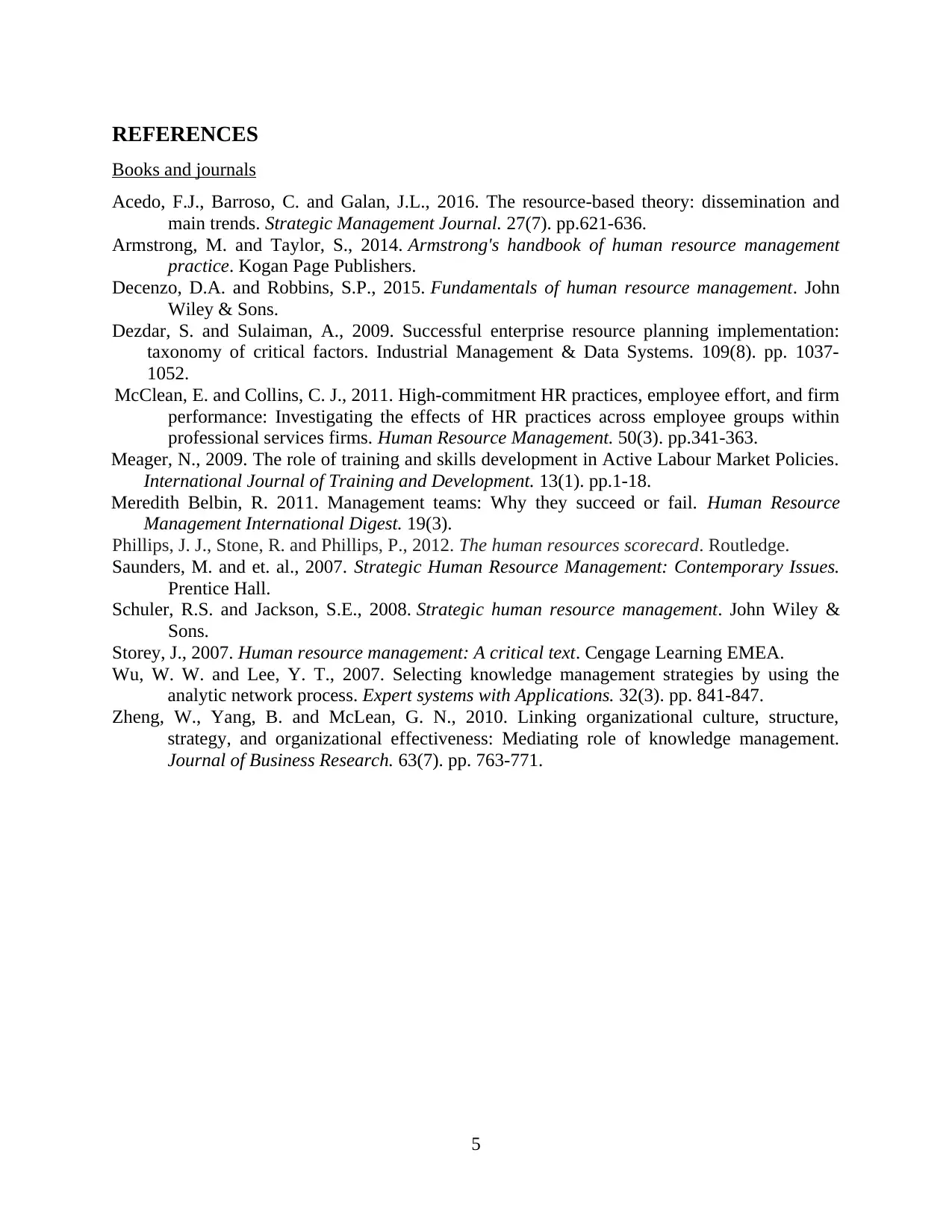
REFERENCES
Books and journals
Acedo, F.J., Barroso, C. and Galan, J.L., 2016. The resource‐based theory: dissemination and
main trends. Strategic Management Journal. 27(7). pp.621-636.
Armstrong, M. and Taylor, S., 2014. Armstrong's handbook of human resource management
practice. Kogan Page Publishers.
Decenzo, D.A. and Robbins, S.P., 2015. Fundamentals of human resource management. John
Wiley & Sons.
Dezdar, S. and Sulaiman, A., 2009. Successful enterprise resource planning implementation:
taxonomy of critical factors. Industrial Management & Data Systems. 109(8). pp. 1037-
1052.
McClean, E. and Collins, C. J., 2011. High‐commitment HR practices, employee effort, and firm
performance: Investigating the effects of HR practices across employee groups within
professional services firms. Human Resource Management. 50(3). pp.341-363.
Meager, N., 2009. The role of training and skills development in Active Labour Market Policies.
International Journal of Training and Development. 13(1). pp.1-18.
Meredith Belbin, R. 2011. Management teams: Why they succeed or fail. Human Resource
Management International Digest. 19(3).
Phillips, J. J., Stone, R. and Phillips, P., 2012. The human resources scorecard. Routledge.
Saunders, M. and et. al., 2007. Strategic Human Resource Management: Contemporary Issues.
Prentice Hall.
Schuler, R.S. and Jackson, S.E., 2008. Strategic human resource management. John Wiley &
Sons.
Storey, J., 2007. Human resource management: A critical text. Cengage Learning EMEA.
Wu, W. W. and Lee, Y. T., 2007. Selecting knowledge management strategies by using the
analytic network process. Expert systems with Applications. 32(3). pp. 841-847.
Zheng, W., Yang, B. and McLean, G. N., 2010. Linking organizational culture, structure,
strategy, and organizational effectiveness: Mediating role of knowledge management.
Journal of Business Research. 63(7). pp. 763-771.
5
Books and journals
Acedo, F.J., Barroso, C. and Galan, J.L., 2016. The resource‐based theory: dissemination and
main trends. Strategic Management Journal. 27(7). pp.621-636.
Armstrong, M. and Taylor, S., 2014. Armstrong's handbook of human resource management
practice. Kogan Page Publishers.
Decenzo, D.A. and Robbins, S.P., 2015. Fundamentals of human resource management. John
Wiley & Sons.
Dezdar, S. and Sulaiman, A., 2009. Successful enterprise resource planning implementation:
taxonomy of critical factors. Industrial Management & Data Systems. 109(8). pp. 1037-
1052.
McClean, E. and Collins, C. J., 2011. High‐commitment HR practices, employee effort, and firm
performance: Investigating the effects of HR practices across employee groups within
professional services firms. Human Resource Management. 50(3). pp.341-363.
Meager, N., 2009. The role of training and skills development in Active Labour Market Policies.
International Journal of Training and Development. 13(1). pp.1-18.
Meredith Belbin, R. 2011. Management teams: Why they succeed or fail. Human Resource
Management International Digest. 19(3).
Phillips, J. J., Stone, R. and Phillips, P., 2012. The human resources scorecard. Routledge.
Saunders, M. and et. al., 2007. Strategic Human Resource Management: Contemporary Issues.
Prentice Hall.
Schuler, R.S. and Jackson, S.E., 2008. Strategic human resource management. John Wiley &
Sons.
Storey, J., 2007. Human resource management: A critical text. Cengage Learning EMEA.
Wu, W. W. and Lee, Y. T., 2007. Selecting knowledge management strategies by using the
analytic network process. Expert systems with Applications. 32(3). pp. 841-847.
Zheng, W., Yang, B. and McLean, G. N., 2010. Linking organizational culture, structure,
strategy, and organizational effectiveness: Mediating role of knowledge management.
Journal of Business Research. 63(7). pp. 763-771.
5
1 out of 7
Related Documents
Your All-in-One AI-Powered Toolkit for Academic Success.
+13062052269
info@desklib.com
Available 24*7 on WhatsApp / Email
![[object Object]](/_next/static/media/star-bottom.7253800d.svg)
Unlock your academic potential
Copyright © 2020–2025 A2Z Services. All Rights Reserved. Developed and managed by ZUCOL.





